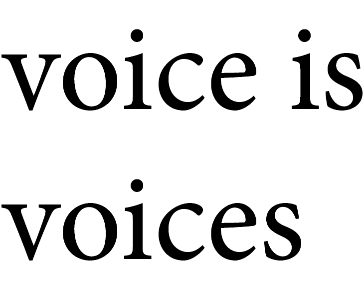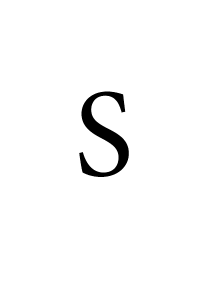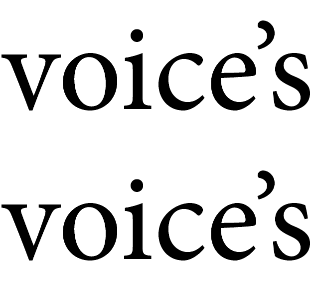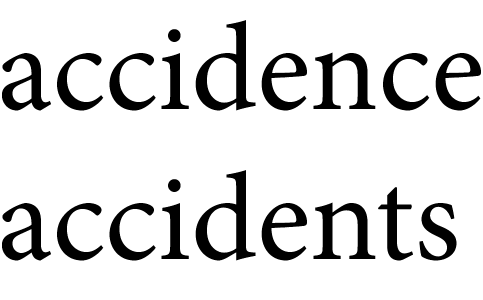Apostrophe plural
This presentation investigated how the experimental re-distribution of apostrophes in the sentence in English disrupts the allocation of grammatical agency. I understand the internal reading voice, which sounds words silently, as a performer. This performer, I suggest, has the capacity to hold the projective and retroactive movement of syntactical reorganisation that the misplaced apostrophe intonates. Exploring the potential of the homophonic blurring of possessives, plurals and contractions, I examine how it is possible to allow for the irresolution of the sentence as a form of thought. This paper documents the elements of my presentation that focussed on practice.
*
I am interested in ways of registering the vocalisation of an internal reading voice. In this work of registration I look for new ways of structuring thought, for inviting in other speakers, and altering a linearity of reading. By registration I mean something similar to hearing your speaking voice in your ears and in the room, an experience of simultaneous speaking and listening.
I am working on ambiguities arising in the vocalisation of a text. Precisely those arising in English through transition – the merging together of words through their sequential pronunciation. I am interested in vowel-to-vowel transition, active between the words ‘voice’ and ‘is’, which, when spoken, hold a sonic similarity to the pluralised version of voice, ‘voices’. You can hear the slight difference when voice is pronounced in the run of a sentence, and then individually: voice is.

I look at ways to use this sonic ambiguity, practicing hearing vocalisations that run counter to a word’s appearance on the page. I am interested in how to attend to alternate syntaxes produced in this way and to propositional modes of thinking and personhood that happen there. I work at the site of the internal vocalisation of the silent reader.

I focus on the morpheme ‘s’ – that component of English that takes part in designating plurals and possessives. I use the misdirection of apostrophe, which supplies an additional semantic ambiguity between voice’s (voice is) (contraction) and voice’s (possessive).
Redrafting texts I had already produced – notes for works, abstracted fictions and paragraph-long scenes – I altered the presentation of the morpheme s at the ends of words, gradually approaching the places where I could work with the registration of a non-continuity between page and vocalisation.

Sometimes apostrophe is present, sometimes it’s absent. Having produced a few of these experimental texts, I presented them at a seminar, sharing the text on screen and simultaneously reading these phrases and others aloud:
‘this is a process by which a long texts adapted for radio’
‘this process’s misaligned with dialogue in the text’
Discussions afterwards suggested the texts were producing a feeling of disorientation in my listeners, who were also silent readers. They experienced the continuity of my intonation as disturbed by their mental registration of a divergent grammar on the page. I work with this sensation as a kind of linguistic material.
At about this time, I was reading about accidence. Accidence are in the sentence. ‘Accidence’ is a linguistic term, describing how the structures of tense, person and number change the shape of words. An example is the morphological modifications of plural and possessive made by the letter s, my companion, with apostrophe, in this work. Vocalised, accidence is the insistent sounding of its homophone accidents, an ironic manifestation of the linguistic orthodoxies of social control.

I heard, in accidence, also a homophonic possibility of dissent or movement that opens up, in excess of irony, in a practice of listening. I worked away from accidence as a grammatical encoding of accidents’ connoted violence. I experimented with trying to listen to the accidental syntaxes my unconventional use of s and apostrophe produced, trying to hear how these alternate syntaxes could be held in the sentence.
As I read I noticed the apostrophes, or their absences, effected retroactive cuts in the sentence. I’ve marked these cuts with a virgule ǀ, or vertical bar, which can also be used to mark the cesura in verse:
This is the process by which a long ǀ texts adapted for radio. The jurors, who number more than the identifiable characters, resist being broken into sections of exposition and sections of dialogue. Would I similarly resist this process’s ǀ misaligned with dialogue in the text.
These cuts my virgules mark are anacolutha – unexpected breakdowns in syntactic continuity. Gradually I began to hear them as interjections from another speaker. This speaker is continuing the sentence in a way grammatically incompatible with the first half. This speaker is hypothecated by the syntax. This speaker enters into the continuity of thought with a retrospective decisive action.
This activity of sentences that produces unexpected actors is not an unfamiliar syntactic feeling. Sarah Wood thinks about the sentence and its actors, considering the example of intransitive verbs, verbs without a direct object. Intransitivity, Wood suggests, could be the success of thought. For Wood it is an affective registration of loss that inheres syntactically in the shape of a figure. Wood writes, ‘the success of thinking is to keep missing what it aims at, not as one misses a target – once and for all – more in the way that one misses a person’. (Wood 2013, 30)
The second definition for the word apostrophe is an act of direct address to an absent person or personified thing. It derives from ‘turning away’. As I read, I understood this as a turning away from the first addressee to another, to someone off to the side, who is producing excepted speech, whose vocalisation is lifted up from the semantics of the sentence. I turn away from the sentence towards another speaking voice (someone I might have missed).
Reading with misplaced s and intermittent apostrophes begins to cue, for me, a switch in voices, to programme a form of prosody. I begin to hear how syntax has a voice that punctuation invites. This, again, is not an unfamiliar syntactic feeling.
Poet Alice Notley ambivalently claims a voice for the work of her metrical feet in The Descent of Alette. The feet, not more than a handful of words long, are bracketed by double quotation marks; several feet appear on each line. Notley tells the reader, in the Author’s Note, that these quotation marks are ‘there mostly to measure the poem…they may remind the reader that each phrase is a thing said by a voice’. (Notley 1996, Author’s Note)
Notley’s punctuation scores a form of mental intonation, or ‘covert prosody’ that Wallace Chafe describes as the ‘auditory images of intonation’ that readers experience in silent reading. (Chafe 1988, 395) The divergence of a semantically informed written punctuation from an intonationally informed one, which Chafe investigates, turns towards an internal prosody I experience temporally, as the extended possibility to hold two thoughts, speaking and listening. I think of the silent reader as a solo performer who remembers, though silent, that ‘each phrase is a thing said by a voice’. (Notley 1996, Author’s Note)
Writer Selah Saterstrom describes the experience of an out loud reading group for Notley’s The Descent of Alette, where ‘Notley’s words [were] heard through the literal voices of other poets’. (Saterstrom 2017, 111) Saterstrom wrote during the sessions, producing ‘ruptured versions of Notley’s sentences’, noting that in this writing practice ‘Notley’s…syntactical paradigms linger’. (Ibid., 110) While these syntaxes draw in voices, and for Saterstrom they incorporate voices from her past, they have no stable ascription. The work she produces, she writes, may not hold these voices very long, ‘but I do not anticipate feeling alone when these present voices slip’. (Ibid., 112)
At the time of presenting, and submitting this text for the proceedings, I am continuing to work with this material collaboratively together with Deirdre Humphrys, investigating how this form of irresolute thought meets the practice of reading aloud and internally with others. In particular I am interested in what happens when two readers aim to read a text which already, syntactically, appears to hold multiple voices, and which operates in part through a performance of silent reading. Together we are looking for ways in which we can hear an internality of voice when we read aloud.
References
Chafe, Wallace. 1988. “Punctuation and the Prosody of Written Language.” Written Communication 5, no. 4 (October 1st, 1988): 395–426. https://doi.org/10.1177/0741088388005004001.
Notley, Alice. 1996. The Descent of Alette. New York: Penguin.
Saterstrom, Selah. 2017. Ideal Suggestions: Essays in Divinatory Poetics. Berkeley, CA: Essay Press.
Wood, Sarah. 2013. Without Mastery: Reading and Other Forces. Edinburgh: Edinburgh University Press.
Contributor
Julia Calver
Julia Calver is an artist and writer working with experimental linguistic morphologies. She is undertaking a practice-based PhD at Sheffield Hallam University (SHU). Recent publications include works in On Care (MA BIBLIOTHÈQUE) and Inscription: The Journal of Material Text (with The Roland Barthes Reading Group). She has performed internationally, including Galleri Box, Gothenburg, and NLHSpace, Copenhagen, and co-organises the peer-led Writing for Practice Forum (Goldsmiths and SHU).